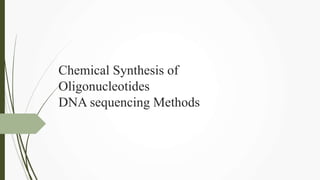
DNA Sequencing.ppt
- 1. Chemical Synthesis of Oligonucleotides DNA sequencing Methods
- 4. Steps
- 5. Linking
- 7. Activation
- 8. Coupling
- 9. Capping
- 10. Oxidation
- 11. Overview
- 13. DNA sequencing DNA sequencing refers to methods for determining the order of the nucleotide bases adenine,guanine,cytosine, and thymine in a molecule of DNA The first DNA sequence was obtained by academic researchers, using laboratories methods based on 2- dimensional chromatography in the early 1970s. By the development of dye based sequencing method with automated analysis, DNA sequencing has become easier and fasterTwo main methods are widely known to be used to sequence DNA: The Chemical Method (also called the Maxam–Gilbert method after its inventors).The Chain Termination Method (also known as the Sanger dideoxy method after its inventor).
- 14. The chain terminator method is more efficient and uses fewer toxic chemicals and lower amount of radioactivity than the method of Maxam and Gilbert. The key principle of the Sanger method was the use of dideoxynucleotide triphosphates (ddNTPs) as DNA chain terminators. The chain termination method requires a single-stranded DNA template, a DNA primer,a DNA polymerase, radioactively or fluorescently labelled nucleotides,and modified nucleotides that terminate DNA strand elongation.
- 15. The DNA sample is divided into four separate sequencing reactions, containing all four of the standard deoxynucleotides (dATP, dGTP, dCTP, dTTP) and the DNA polymerase. To each reaction is added only one of the four dideoxynucleotide (ddATP, ddGTP, ddCTP, ddTTP) which are the chain terminating nucleotides, lacking a 3’-OH group required for the formation of a phosphodiester bond between two nucleotides, thus terminating DNA strand extension and resulting in DNA fragments of varying length.
- 16. The newly synthesized and labelled DNA fragments are heat denatured, and separated by size by gel electrophoresis on a denaturing polyacrylamide-urea gel with each of the four reactions run in one of the four individual lanes (lanes A, T, G, C).The DNA bands are then visualized by autoradiography or UV light, and the DNA sequence can be directly read off the X- ray film or gel image. A dark band in a lane indicates a DNA fragment that is result of chain termination after incorporation of a dideoxynucleotide (ddATP, ddGTP, ddCTP, or ddTTP). The relative position of the different bands among the four lanes are then used to read (from bottom to top) the DNA
- 17. The technical variations of chain termination sequencing include tagging with nucleotides containing radioactive phosphorus for labelling, or using a primer labelled at the 5’ end with a fluorescent dye. Dye- primer sequencing facilitates reading in an optical system for faster and more economical analysis and automation
- 20. 1. The double-stranded fragment to be sequenced is isolated and radioactively labeled at the 5’-ends with 32P. 2. The fragment is then cut with restriction enzyme and thus the label is removed from one end. 3. The fragment of DNA with one end labeled is denatured. 4. Four identical samples of these end-labeled DNA restriction fragments are subjected to chemical cleavage at different chemical nucleotides. 5.There are four specific sets of chemical reactions that selectively cut the DNA backbone at G, A+G, C+T, or C residues. G only: Dimethyl sulphate(DMS) and piperidine A+G : DMS, formic acid and piperidine C+T : Hydrazine, piperidine C only : Hydrazine, alkali (1.5M NaCl) and piperidine
- 21. 6. For each labeled chain to be broken only once, the reactions are controlled. 7. The labeled sub-fragments created by the four reactions have the 32P label at one end and the chemical cleavage point at the other end. 8. The reaction products are separated by polyacrylamide gel electrophoresis which is based on size. Smallest fragment goes fastest. Figure: Apparatus for gel electrophoresis Voet, D.; Voet, J. and Pratt, C. (upgrade ed) Fundamentals of Biochemistry; John Wiley and Sons, Inc (2002); p 58
- 22. 9. The labeled fragments in the gel are visualized by autoradiography. 10. The sequence is read from bottom to top of the gel. Figure: Maxam-Gilbert method Lodish, H.;Berk, A. et. al. (4th ed); Mol. Cell Biol.; W. H. Freeman and Co. (2000) p: 233
- 26. NGS
- 27. NGS
- 28. NGS
- 29. NGS
- 30. DNA supercoiling
- 37. The linking number is a topological property of DNA. A linking number is a sum of twists and writhes. The number of times one strand of DNA turned around another strand is called a twist while inter-coiling of the double helix is termed as writhe. In short, writhe is a number of a time DNA double helix is crossed, coiled over each other or the number of times one strand wraps around another strand. If both ends of DNA are joined, the linking number remains unchanged, (the linking number is zero in the case of circular DNA molecule). So if we want to change the linking number, we have to break the DNA strand and that function is performed by DNA Topoisomerase